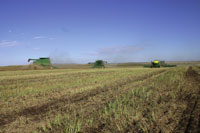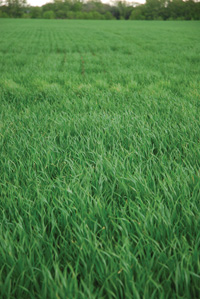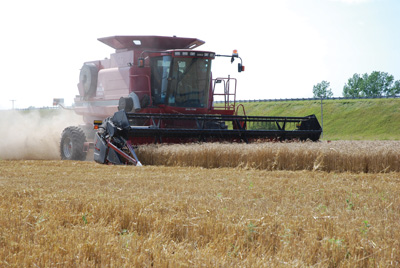
Features
Agronomy
Cereals
What did 2009 teach growers about winter wheat?
In the spring of 2009, the prospects for Ontario’s winter wheat crop looked dismal. Yet yields in most areas turned out to be quite good.
August 13, 2010 By Carolyn King
In the spring of 2009, the prospects for Ontario’s winter wheat crop looked dismal. Yet yields in most areas turned out to be quite good.
Looking back, it is easy to see how a combination of better practices, better genetics, and a late season smile from Mother Nature helped growers realize good yields despite weather challenges.
 |
|
| New varieties developed specifically for Ontario with combinations of important strengths have improved crop performance.
|
Downs and ups from Mother Nature
The 2009 crop certainly faced some tough conditions. Although fall seeding was a little late, the main problem was that immediately after most of the crop was seeded, the weather turned cold and wet. “The wheat crop went into the winter in very poor shape because of the very cold fall temperatures and wet conditions. Wheat really does not like wet feet until it has emerged. Once it’s emerged and has leaves up, it can transport oxygen from the air down to its roots. But if it’s all underground, it has no opportunity to do that,” says Peter Johnson, cereals specialist with the Ontario Ministry of Agriculture, Food and Rural Affairs (OMAFRA).
 |
|
| An early nitrogen application can help a poor winter wheat stand in spring. Photos by Ralph Pearce. |
Another challenge came in mid-winter. Johnson explains, “In some parts of the province, all the snow melted in February, and then we got extremely cold temperatures around -26 degrees C. I was concerned the cold temperatures with no snow cover might kill wheat. That is extremely rare in Ontario; in fact it only happened once in all of the 20th century. The LT50, the lethal temperature where half of the wheat plants would die, is -22 degrees at the crown, so the ‑25 to -28-degree air temperatures were very concerning.”
Then, in March, many areas suffered frequent freeze-thaw cycles. “We had a tremendous amount of frost heave particularly in fields where growers didn’t get the wheat planted deep enough or the wheat didn’t have a chance to make any root system to anchor itself,” notes Johnson. “So by April 15th, we had the poorest looking wheat crop that I’ve seen since the spring of 1993.”
There was a brief window of opportunity to apply nitrogen in mid-April. “When you have a poor wheat crop, early nitrogen really does boost the crop. Some growers put nitrogen on, even though the wheat fields looked awful on April 15th, and many of those fields caught hold of the nitrogen. They got some moisture to help them re-root through late April. And by the middle of May, they looked pretty respectable,” says Johnson.
“Other growers put off making a decision on nitrogen application because they weren’t sure whether they would keep the crop. But around April 22nd, it started to pour rain, and in some parts of the province it really didn’t dry out enough to be able to drive over the field until May 10th or even May 20th. So growers who chose not to put nitrogen on their wheat crop in mid-April, most of those wheat crops were ‘Roundup ready’ by the time the growers could get back into the field.”
As a result, Johnson was predicting overall poor winter wheat yields for the province. “By May 15th, I was saying, ‘If we break 70 bu/ac we should be pretty thankful, and at very optimistic, maybe we’ll hit 72.’ But then we got into this wonderful weather for the wheat crop with a long, cool grain-fill period, and ample moisture for grain-fill, not everywhere, but in much of the province. So we ended up with a provincial average of 75.2 bu/ac.”
He adds, “I talked to so many growers in 2009 who said they really didn’t know whether they should have kept the crop or not. I walked those fields, and in some cases crop insurance wrote them off and said they’re not worth keeping. But because the weather turned wet, growers ended up keeping them. And a lot of those fields yielded in that 70 bu/ac range, with the really poor ones yielding 70 bu/ac when 50 bu/ac would have been more what we would have expected.”
Johnson says the quality of the 2009 winter wheat crop varied with the local weather conditions at harvest. “In general, across the entire province, we were pleasantly surprised with the quality. We were pretty concerned that we might see fairly high Fusarium levels, but we did not see that. Our falling numbers were acceptable. Our test weights were good. The crop as a whole was sound.”
He notes, “But there were definite pockets and also classes of wheat where there were significant problems.” For example, the Brantford to Simcoe area and the Peterborough to Lindsay area had wet weather at harvest time resulting in tremendous trouble with sprouting, low falling number and mildew. He adds, “Across the province we had big trouble with sprouting in the soft white winter wheat crop because soft white does not have good sprout tolerance.”
Fine-tuning field practices for better yields
The 2009 winter wheat crop is not the only one in recent years for which overall yields were better than expected, despite difficult conditions. OMAFRA tracks provincial wheat yields every year, and those data show a trend of overall increasing yields. Johnson says, “Twenty years ago, average wheat yields were 60 bu/ac. For 2010, our trend line yield is 80.1 bu/ac.”
 |
|
| Improved practices and better genetics have increased the average winter wheat yield from 60 bu/ac two decades ago to 80.1 bu/ac for 2010.
|
That upward trend in yield results from a combination of stronger varieties and better practices, helping the crop to perform well even in years like 2008-09 when conditions were not optimal.
Johnson identifies some key improvements in practices. “Starter fertilizer with the seed helps the wheat plant get off to a better start. Using fungicides appropriately at the right time and with the right nozzles, proper nitrogen amounts, effective weed control, the entire management program contributes to better performance. Even simple things like planting depth can make a difference. And we continue to improve in this.”
Marty Vermey, product manager at Hyland Seeds, gives a few examples of practices that helped growers for the 2009 winter wheat crop, such as applying nitrogen in the spring to thin stands and seeding the crop at the right depth for good root development and resistance to frost heave.
Vermey adds, “I remember as a teenager, growers were trying to aerial broadcast seed for winter wheat on their soybean crop. The resulting wheat stands were weak and thin, and in some years the wheat just got heaved out. Nobody really had a great wheat yield.
“But nowadays, we try for good management on all our crops: uniform seed depth, uniform emergence, good root system development.
We always think about our top-growth and control disease and insect pressure, but we also have to think about our roots. A lot of our yield comes from how we take care of our roots, like tillage practices and making sure we’re not compacting our soil. Allow your roots to grow and thrive, having a healthy soil so the root system can spread out and get all the nutrients possible. That helps build the plant and maximize grain development. Getting the plant stand uniform, so that every plant is going to give you 110 percent; that’s where you get your extra yield.”
Barry Gordon, sales and marketing manager with C&M Seeds, identifies four key management categories for a profitable winter wheat crop: fall management, spring management, summer management, and marketing management. “If you just did one of them well, it wasn’t good enough for the 2009 crop because it was challenging. Growers who perfected all four categories were pretty successful.”
For fall management, Gordon says that growers who used starter fertilizers, certified seed and proper seeding depth in 2008 were in a much better position to deal with weather challenges. “We have seen on average five to nine bu/ac increases with starter fertilizer; it gets the plant off to a better start so it has a better root system going into the winter. And growers who planted certified seed had more uniform stands going into winter. Growers using their own seed didn’t have proper treatments on that seed, so when they had challenges in the fall, at lot of that seed grew unevenly.”
Gordon provides a tip for proper seeding depth, another important factor in fall management. “With a lot of the drills, growers have to put extra pressure behind the tractor wheels when conditions are less than ideal to get the wheat seed covered behind the tire tracks. If they leave the same pressure across the entire drill, they get extra deep planting in the areas where there are no wheel tracks, which results in uneven depth of planting. And when it is cold and wet, that really shows up with uneven emergence. So growers need to fine-tune seeding depth with their equipment.”
Like Johnson and Vermey, Gordon says an early spring nitrogen application on plants that were very small going into the winter was crucial for good yields in 2009. He also suggests that growers consider using nitrate-nitrogen fertilizer (28 percent UAN applied with streamer nozzles), rather than urea, when soils are cold and wet, so the nitrogen will be readily available.
Summer management is much easier if fall and spring management are performed properly, notes Gordon. “If some part of spring and fall management was less than stellar, then growers had an uneven flowering crop when it came to the summer.” Uneven flowering makes it very difficult to get the correct timing for fungicide applications.
Finally, in terms of marketing, Gordon says 2009 showed the importance of thinking through decisions on which wheat classes to grow. “Many growers grow soft red wheat, and this happened in 2009, strictly because it takes slightly less nitrogen than the hard red wheat. Hard red wheat (in 2009) was virtually a niche market, so those who grew hard red wheat were very well rewarded. If there isn’t enough supply of a specific class of wheat that the mills want, then it’s going to demand a much higher price.” He adds, “One stellar rule is, if the price is good, sell some!”
Dr. Duane Falk a plant geneticist at the University of Guelph, emphasizes that growers need to know their own situation: which varieties are best, which inputs are required at what rates and at what timing for their own conditions.
However, he cautions, “We don’t know enough yet about everything, unfortunately. It’s really hard to come up with a recipe that will work every year, partly because we can’t predict what’s going to happen down the line. A lot of the inputs need to go on before the problem shows up. And judging that and doing it in such a way that it pays off is still a bit of a risk. Like agriculture in general!”
On the positive side, he says there are more advanced decision-making tools available to help growers make better and earlier judgment calls.
And of course, it never hurts to have a bit of luck with the weather.
| Better traits in better packages Just as agronomists and growers have been improving how winter wheat is grown, breeders have been improving the wheat that is grown. New varieties have combinations of strengths that allow the crop to perform well even when the weather does not co-operate. Disease resistance is an important part of those improvements. Dr. Duane Falk, a plant geneticist at the University of Guelph, says, “We’re getting material with better packages of disease resistance, primarily Fusarium resistance, although it’s nowhere near where we’d like it to be, and that is being combined with resistance to diseases like powdery mildew and leaf rust. In the past, it seemed like the varieties that were better for Fusarium were worse for the other diseases and vice versa. Now, we have varieties with good combinations of disease resistance, so they perform closer to their potential even in years when weather conditions are better for the diseases. And that leads to stable, high performance.” Peter Johnson, cereal specialist with the Ontario Ministry of Agriculture, Food and Rural Affairs (OMAFRA), emphasizes that improved disease resistance is “a moving target,” with an ongoing need for better varieties. “If we bring out a variety with great powdery mildew tolerance, then that variety becomes a significant player in the marketplace. That puts selection pressure on the powdery mildew disease organism, so it evolves and overcomes the tolerance of that wheat variety.” Yields and grain quality are also getting better. “The test weights seem to be a little higher and more stable. And the kernel weights seem to be a little higher, which may be a reflection of their improved disease resistance,” says Falk. Johnson also notes that improved standability has contributed to better yields. And Barry Gordon, sales and marketing manager with C&M Seeds, agrees; “We now have varieties that will stand when we put on extra nitrogen. Some of the older, taller varieties tended to lodge with higher nitrogen rates. We brought out a new hard red wheat last year with much shorter straw and it has done very well with standability, and I don’t think we’re alone with these sorts of improvements.” Falk adds, “If you look back historically, a lot of the winter-hardy varieties were quite tall. By emphasizing winter hardiness, we wound up inadvertently with quite a few tall varieties. Now, we are getting better winter hardiness combined with shorter straw.” Marty Vermey, product manager at Hyland Seeds, points out yet another important consideration. “If we go back probably 20 years, wheat yields were pretty stagnant, with only a few varieties available. Variety development was mainly left to the public sector, which only had one or two breeders, so development was slower. Now variety development is occurring at a much faster rate and therefore crop improvement is a lot quicker and higher. For instance, two or three years ago, we had some tremendous wheat yields, breaking 100 bu/ac in some areas of Southwestern Ontario, which was unheard of 20 years ago.” Vermey adds, “Our breeders are testing hundreds of thousands of lines every year in the crosses they make to find the best genetics and test them for multiple years. Also, we look for products that can respond in the fertility regime and the disease pressure here in Ontario. You really can’t take a variety from Britain, for instance, that grows in a different climate, different fertility, different fungicide program, and try to develop that product here, because it wasn’t developed and selected for our conditions. We’re breeding and selecting here in Ontario, with Ontario conditions and management practices, and that’s critical for variety development.” Gordon notes one caveat: “New genetic developments have always been driven by the purchase of certified seed. However, an awful lot of growers want to cut their costs in the short term by not purchasing certified seed. As the purchasing of certified seed declines, the money for research and development declines. That really hurts our industry when we don’t have as many new varieties coming on to the market.” Falk reminds growers to visit the Go Cereals website (www.gocereals.ca ) for information on varieties to fit their own situation. |